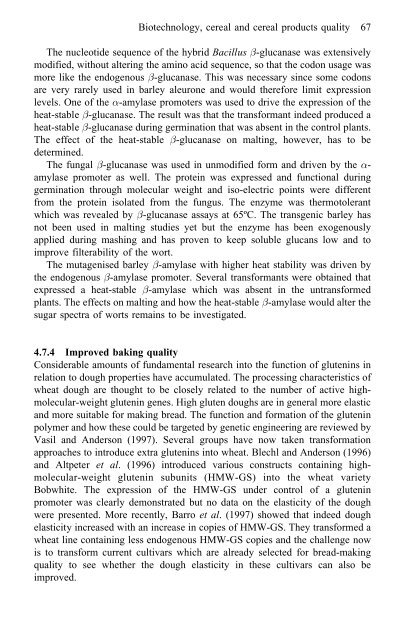Cereals processing technology
Cereals processing technology
Cereals processing technology
Create successful ePaper yourself
Turn your PDF publications into a flip-book with our unique Google optimized e-Paper software.
Bio<strong>technology</strong>, cereal and cereal products quality 67<br />
The nucleotide sequence of the hybrid Bacillus -glucanase was extensively<br />
modified, without altering the amino acid sequence, so that the codon usage was<br />
more like the endogenous -glucanase. This was necessary since some codons<br />
are very rarely used in barley aleurone and would therefore limit expression<br />
levels. One of the -amylase promoters was used to drive the expression of the<br />
heat-stable -glucanase. The result was that the transformant indeed produced a<br />
heat-stable -glucanase during germination that was absent in the control plants.<br />
The effect of the heat-stable -glucanase on malting, however, has to be<br />
determined.<br />
The fungal -glucanase was used in unmodified form and driven by the -<br />
amylase promoter as well. The protein was expressed and functional during<br />
germination through molecular weight and iso-electric points were different<br />
from the protein isolated from the fungus. The enzyme was thermotolerant<br />
which was revealed by -glucanase assays at 65ºC. The transgenic barley has<br />
not been used in malting studies yet but the enzyme has been exogenously<br />
applied during mashing and has proven to keep soluble glucans low and to<br />
improve filterability of the wort.<br />
The mutagenised barley -amylase with higher heat stability was driven by<br />
the endogenous -amylase promoter. Several transformants were obtained that<br />
expressed a heat-stable -amylase which was absent in the untransformed<br />
plants. The effects on malting and how the heat-stable -amylase would alter the<br />
sugar spectra of worts remains to be investigated.<br />
4.7.4 Improved baking quality<br />
Considerable amounts of fundamental research into the function of glutenins in<br />
relation to dough properties have accumulated. The <strong>processing</strong> characteristics of<br />
wheat dough are thought to be closely related to the number of active highmolecular-weight<br />
glutenin genes. High gluten doughs are in general more elastic<br />
and more suitable for making bread. The function and formation of the glutenin<br />
polymer and how these could be targeted by genetic engineering are reviewed by<br />
Vasil and Anderson (1997). Several groups have now taken transformation<br />
approaches to introduce extra glutenins into wheat. Blechl and Anderson (1996)<br />
and Altpeter et al. (1996) introduced various constructs containing highmolecular-weight<br />
glutenin subunits (HMW-GS) into the wheat variety<br />
Bobwhite. The expression of the HMW-GS under control of a glutenin<br />
promoter was clearly demonstrated but no data on the elasticity of the dough<br />
were presented. More recently, Barro et al. (1997) showed that indeed dough<br />
elasticity increased with an increase in copies of HMW-GS. They transformed a<br />
wheat line containing less endogenous HMW-GS copies and the challenge now<br />
is to transform current cultivars which are already selected for bread-making<br />
quality to see whether the dough elasticity in these cultivars can also be<br />
improved.



